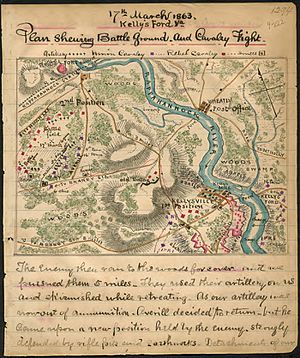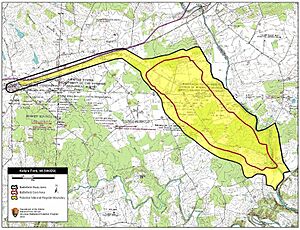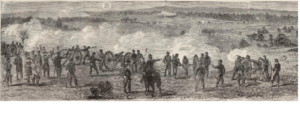Battle of Kelly's Ford facts for kids
Quick facts for kids Battle of Kelly's Ford |
|||||||
|---|---|---|---|---|---|---|---|
| Part of the American Civil War | |||||||
 Plan showing battleground and cavalry fight, March 17, 1863, Kelly's Ford, Virginia. |
|||||||
|
|||||||
| Belligerents | |||||||
| Commanders and leaders | |||||||
| William W. Averell | Fitzhugh Lee | ||||||
| Strength | |||||||
| 2,100 | 800 | ||||||
| Casualties and losses | |||||||
| 78 total 6 killed 50 wounded 22 missing |
133 total 11 dead 88 wounded 34 captured |
||||||
The Battle of Kelly's Ford was a cavalry battle during the American Civil War. It happened on March 17, 1863, in Culpeper County, Virginia. This fight was important because it showed that the Union cavalry was becoming stronger. It also set the stage for bigger cavalry battles later that summer.
About 2,100 Union cavalry soldiers, led by Brigadier General William W. Averell, crossed the Rappahannock River. They wanted to attack Confederate cavalry that had been bothering them. Brigadier General Fitzhugh Lee led about 800 Confederate soldiers to fight back. The Union forces had some success but pulled back later in the day. Neither side won a clear victory.
Why the Battle Happened
After a tough winter, the Union Army was getting ready for new fights. Their leader, Major General Joseph Hooker, made big changes. He brought all the smaller cavalry units together. This new Cavalry Corps was led by Major General George Stoneman. Before this, the Union cavalry often struggled against the Confederate cavalry. The Confederates were led by Major General J.E.B. Stuart. Even though the Union had more men and better equipment, they lacked confidence.
In February 1863, Confederate cavalry, led by Brigadier General Fitzhugh Lee, attacked near Hartwood Church. Lee was General Robert E. Lee's nephew. His 400 soldiers captured 150 Union prisoners. This made General Hooker very angry. He told Stoneman to stop these raids.
Fitzhugh Lee also sent teasing messages to his old friend, William Averell. They had been classmates at West Point. One message said, "I wish you would put up your sword, leave my state, and go home. You ride a good horse, I ride a better. If you won't go home, return my visit, and bring me a sack of coffee."
Averell's scouts soon found Confederate cavalry near Culpeper Court House. Averell gathered 2,100 cavalrymen and six cannons. He headed for Kelly's Ford on the Rappahannock River. Fitzhugh Lee's brigade had 800 men and two cannons. The stage was set for a showdown.
The Battle Begins
On the morning of March 17, 1863, Averell's soldiers reached Kelly's Ford. They found that Confederates had blocked the crossing with fallen trees. About 60 Confederate sharpshooters were also there. Three attempts to cross the river failed. This delayed the Union advance for over 90 minutes.
Finally, Major Samuel E. Chamberlain led 20 men from the 1st Rhode Island Cavalry Regiment. They bravely forced their way across the river. Chamberlain was wounded in the head. Even after crossing, Averell moved slowly. It took him over two hours to get all his men across the fast-moving river.
Fitzhugh Lee, who was 10 miles away, heard about the crossing attempts. He thought Averell was heading for Brandy Station, Virginia. Lee quickly sent his 800 men to stop the Union advance. They met the Union cavalry about 2 miles from Kelly's Ford.
Jeb Stuart, the famous Confederate cavalry leader, was also nearby. He rode to watch the battle. He brought his artillery chief, Major John Pelham. Stuart saw that Lee's men were struggling. They were outnumbered two to one. It was a tough fight for the Confederates.
Lee's soldiers attacked with five regiments. The 3rd Virginia Cavalry and 5th Virginia Cavalry tried to find a gap in a stone fence. Major Pelham moved forward with Lee's men. As he waved them through a gate, a shell exploded above him. A small piece of metal hit his brain. He was badly wounded and died a few hours later. The Confederate attack was stopped by Union carbine fire and cannon shots.
On the Union side, Colonel Alfred N. Duffié charged forward. He did this even though Averell told him to hold his position. This surprise attack forced Lee's men to pull back. Lee counterattacked, but again had to retreat. The Union had more soldiers and cannons. A full Confederate defeat might have happened. But Captain Marcus Reno did not move his men forward to help Duffié. He stayed in his original position.
After the Battle
By 5:30 p.m., Averell decided to pull his troops back. He said his men and horses were tired. He left behind two wounded Confederate officers, a bag of coffee, and a message for Fitzhugh Lee. It said: "Dear Fitz, Here's your coffee. Here's your visit. How do you like it?" Some Union officers thought Averell lost his nerve. They worried about Jeb Stuart being there. They also heard train sounds and feared more Confederate soldiers were coming.
The Union advance had covered only 2 miles in over 12 hours. The Union lost 78 soldiers. Six were killed, 50 wounded, and 22 missing. The Confederates lost 133 soldiers. Eleven were killed, 88 wounded, and 34 captured. The death of young Major Pelham, only 24, was a big shock. He was highly respected by Robert E. Lee and Stuart.
There were men in our lines who were engaged at Malvern Hill, at Gaines Mill, in many of Jackson's Battles, and with one accord they say that they never passed through such a fearful fire as thinned our ranks in that charge.
The Battle of Kelly's Ford was a big boost for the Union. Before this, Confederate cavalry had often beaten them. This made Union soldiers feel bad. But at Kelly's Ford, the Union cavalry showed they could fight well. This changed how they felt about themselves. They went into the summer campaigns of 1863 with more confidence.
However, the Confederates still won a small victory. Averell pulled back too soon. This meant Lee's soldiers kept control of the battlefield. Lieutenant Joseph A. Chedell, a Union soldier, called Kelly's Ford "the first real, and perhaps the most brilliant, cavalry fight of the whole war."
Kelly's Ford was used often during the Civil War. It was also the site of two other important battles later that year. These were the Battle of Brandy Station in June and a fight during the Bristoe Campaign in November.
Battlefield Preservation
Today, the American Battlefield Trust works to save important Civil War battlefields. They and their partners have protected over 1,370 acres of the Kelly's Ford battlefield. This area is part of the C.F. Phelps Wildlife Management Area. It has hiking trails and signs that explain the battle. There is also a memorial to Major John Pelham, who died here.



